Abstract
The theme of the paper is part of a preliminary research that follows several aspects regarding the education of psychomotricity for the child with mental deficiency, aiming at introducing new elements of modern technology, namely virtual interactive game, in the therapeutic-educational act using the Kinect sensor. Purpose of the research: To study the possibility of including virtual interactive game in the kinetotherapy activity for the child with mental deficiency. The research was carried out at Special School no. 8, Bucharest, between February 2017 and April 2017, the group of subjects being made up of 5 pupils with mild and moderate mental deficiency, from primary education. The research was based on the experimental method for the verification of work tools and introduction of virtual interactive game in kinetotherapy activity. Results: Children demonstrated better concentration of attention and an increase in motivation to accomplish their work tasks in the kinetotherapy activities performed using virtual interactive games, associated with classical didactic means, the development of the spirit of competition and/or an improvement in the collaboration relationship with the partner (when there were more participants in the game). Conclusions: The purpose of the research was achieved, the children being very pleased with the inclusion of virtual interactive game in kinetotherapy activity. The inclusion of computerised didactic means, offers of modern technology, in motor activities could contribute to improving the quality of life of children with mental deficiency, because they are, like all children, attracted to such devices specific to contemporary life.
Keywords: Virtual interactive gameKinect sensorkinetotherapy
Introduction
Kinetotherapy uses movement as a specific means, aiming at the somato-functional, motor and psychomotor rehabilitation, and in the case of partially reversible or irreversible deficiencies, the re-education of compensatory functions (MECT, 2008, p. 2).
Psychomotricity education occupies an important place in educational therapy, considering that mental deficiency is often associated with motor deficiencies (Gherguț, 2005, p. 171).
Epuran and Stănescu (2010) say that the game fulfils the “complex function of stimulating movements, the formative-educational function, the balancing and toning function, the therapeutic function. These functions highlight the role of the game in the formation of the individual” (p. 188).
The child finds in play “a favourable environment for motor, affective, cognitive involvement” (Negulescu, 2006, p. 26).
The more the materials used in the game are varied, dynamic and modern, the more the playful activity becomes enjoyable, attracting the child into the learning process. Modern education techniques, resulting from the association of certain information-carrying materials (software), with devices specially designed to value such materials (hardware) (Cerghit, 1988), have also begun to put their mark on game activities for children with special educational needs (Griffiths, 2002; Karal, Kokoç, & Ayyıldız, 2010).
Modern technology allows the creation of educational systems that include modalities of multiple interactions designed to meet the various needs of the user. One of the technological advances refers to movement interaction devices, which help create learning systems where users are able to interact with them in a continuous and active way (Garrido, Penichet, Lozano, & Sanchez, 2012, p. 883).
Movement interaction devices include Kinect (a 21st century invention), its name coming from ‘kinetic’ (movement) and ‘connect’ (the direct person-to-device link) (Melgar, Diez, & Jaworski, 2012, p. 25). Due to the Kinect device, users have the opportunity to interact with the virtual environment through natural gestures.
Kinect has been shown to be useful in the activity with children with special educational needs to improve eye-hand coordination, visual memory, attention concentration (Altanis, Boloudakis, Retalis, & Nikou, 2013).
Problem Statement
The theme of the paper is part of a preliminary research that analyses several aspects of psychomotricity education for the child with mental deficiency, aiming at introducing new elements of modern technology, namely virtual interactive game, in the therapeutic-educational act using the Kinect sensor.
Research Questions
The research hypothesis: children with mental deficiency are attracted, in their game, by modern technology devices used in ameliorative intervention programs.
Purpose of the Study
The research aims to examine the possibility of including virtual interactive game in the kinetotherapy activity performed with the child with mental deficiency, by observing their interest in participating in such activities.
Research Methods
The research methods used were: the bibliographic study method, the observation method, the conversation method, the recording method and technique, the experimental method, the statistical-mathematical method, the computerised graphical method and technique.
The experimental method for verifying work tools and introducing virtual interactive game in kinetotherapy activity was the basic method of research.
The bibliographic study method was used throughout the research period, but especially in February 2017, and consisted in searching and reading the bibliography on the use, in the education and therapy of children with special educational needs, of the game in general and the virtual interactive game, in particular.
The observation was experimental, caused by the researcher by organizing the virtual interactive game.
The conversation method consisted in a dialogue between the researcher and subjects to clarify some concerns about the rules of virtual interactive game.
The recording method and technique were used through the Questionnaire on the subject’s opinion at the end of the virtual interactive game.
After playing the first virtual interactive game (Golf – Ocean Driver from Kinect Sports, Season 2), a game based on simulation of movements, we applied a questionnaire with 7 items (adaptation after Bossavit, 2016, p. 260) to get feedback about the child’s joy to participate in the game, understanding of the rules of the game, ease of playing, desire for competition, progress and participation in other games of this kind. Responses to the items of the questionnaire (Table
The experimental method was used to verify the hypothesis and purpose of the research. In this preliminary experimental research, we used the Kinect sensor. Among the advantages of virtual interactive game using the Kinect sensor, we mention:
attractive design;
relatively short duration and immediate assessment of the results;
rewards: score/ranking; verbal and gestural appreciations from virtual supporters (sports) or stars (dance);
constantly prompts attention;
stimulates the desire to succeed;
develops the spirit of competition (if there are more players in the game);
the variety of movements required by the game can be used to educate motor skills and psychomotricity.
The statistical-mathematical method was used for summarising, processing and comparing the data obtained from the application of the questionnaire.
The computerised graphical method and technique were used to interpret suggestively the problems studied. The calculated indicators were represented by charts, using the Microsoft Excel application from the Microsoft Office software package.
Findings
Description and conduct of research
The research was carried out at Special School no. 8, sector 1, Bucharest, between February 2017 and April 2017, the group of subjects being made up of 5 pupils with mild and moderate mental deficiency, from primary education.
The materials used were: Kinect XBOX 360, XBOX 360 console, TV monitor, virtual interactive games from the Kinect Sports, Season 2 collection, and the Nickelodeon Dance 2 collection.
One of the types of virtual interactive game used in the preliminary research was the sports game in the Kinect Sports, Season 2 collection, a game based on movement simulation.
Before the game, we made a brief presentation of its rules, followed by the demonstration of the game, after which we guided and helped the children play the game.
The subject is guided step by step in choosing menu items, the control being held by hand action. Thus, in selecting one of the six sports, the subject will go through the following steps: raises a hand with the palm facing the screen, moving it until the hand on the screen moves, and then directing the hand to the desired game. Once the game has been selected, the subject will raise a hand above the head, a sign that the game can start. The next steps depend on the nature of the game. For example, in the Golf – Ocean Driver game (Figure
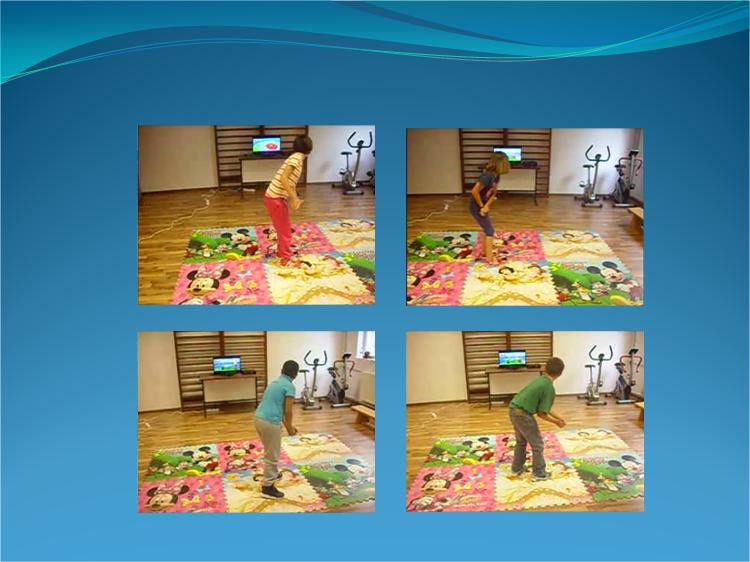
During the game, before each “hit” executed with the hands together, the child will adjust his/her position moving forward or backward, so as to hit the target on an island.
The score is set as follows: 1 point for a hit in the green area, 2 points for the purple area and 3 points for the red area. If the ball does not reach the island, but falls into the water, the child does not receive any point for that hit. The subject is entitled to 10 “kicks”, receiving the score at the end of the game and being congratulated.
This game contributes in particular to the education of spatial orientation, body schema and management of actions.
Also from the sports game category, we used the virtual interactive game Skiing (Figure
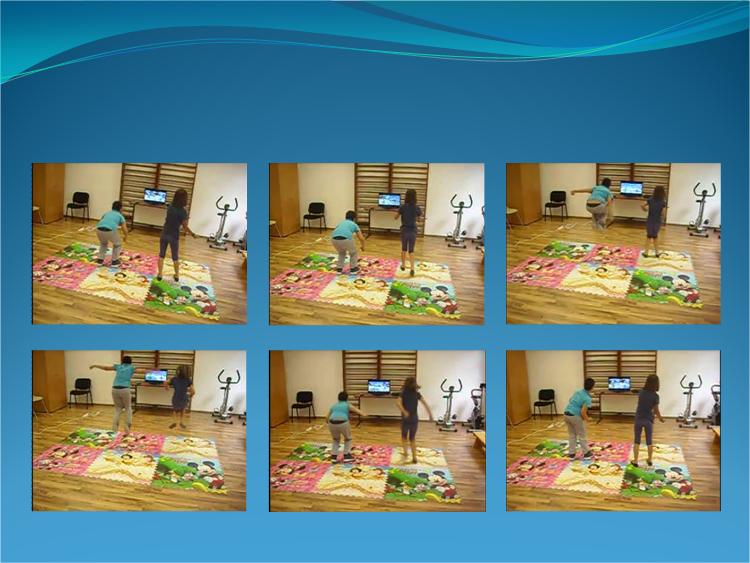
Another type of virtual interactive game was the dance-rhythm game, using the Nickelodeon Dance 2 collection, a game based on movement imitation. We chose the Freeze Dance game. The child dances imitating the movements of the child on the screen. During the dance, the element of maximum attention is when, at certain moments of the dance, the child must remain motionless. This game contributes to improving intersegmental and general coordination (jumping from one foot to the other simultaneously with various movements of the arms on the same side), spatial orientation (turning the body to the right-left, left-right lateral movements of the lower and upper limbs, down-up and forward-backward hand movements like a windmill) and attention, as well as educating balance (moments when the body must remain motionless). This game can be played by a single child (Figure
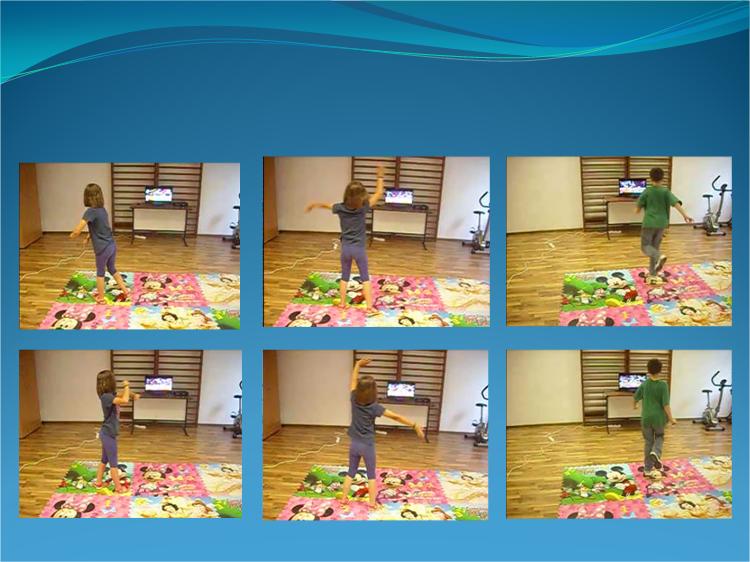
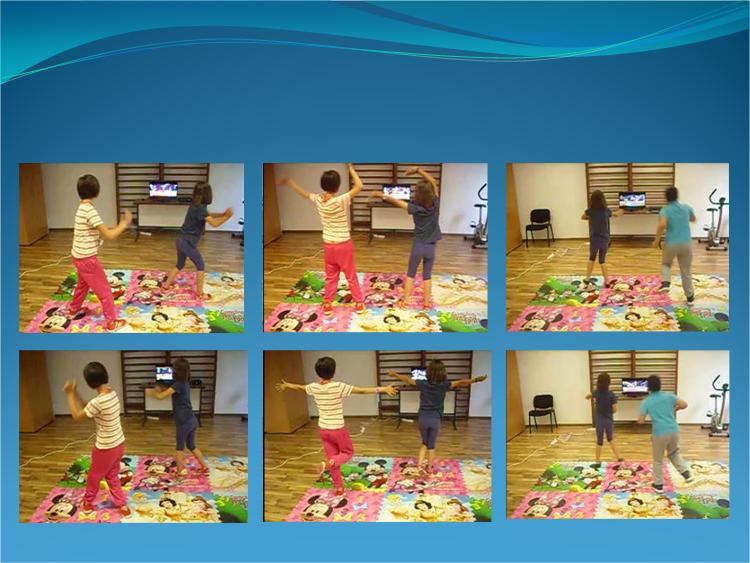
Results
The results obtained in the Questionnaire on the subject’s opinion at the end of the virtual interactive game were summarised in Table
According to Table
The level of children’s satisfaction with the participation in a virtual interactive game is illustrated in Figure
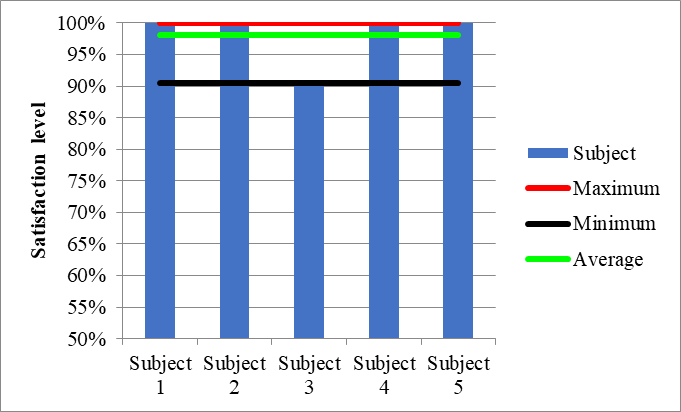
From Graph
In the kinetotherapy activities performed using virtual interactive games (Golf – Ocean Driver, Skiing and Freeze Dance), children in the group of subjects showed better concentration of attention and an increase in motivation to accomplish their work tasks, the development of the spirit of competition and/or an improvement in the collaboration relationship with the partner (when there were more participants in the game).
Conclusion
The research hypothesis was verified, and the research purpose was reached, the children being very pleased with the inclusion of virtual interactive game in kinetotherapy activity. The inclusion of computerised didactic means, offers of modern technology, in motor activities could contribute to improving the quality of life of children with mental deficiency, because they are, like all children, attracted to such devices specific to contemporary life.
References
- Altanis, G., Boloudakis, M., Retalis, S., & Nikou, N. (2013). Children with motor impairments play a Kinect learning game: First findings from a pilot case in an authentic classroom environment. Interaction Design and Architecture(s) Journal, 19, 91-104.
- Bossavit, B. (2016). Designing and implementing digital educational tools for children and youth with special needs using Natural Interfaces (Appendix VI: Scenario Experience Feedback Questionnaire) (Doctoral thesis). Pamplona. Retrieved from https://academica-e.unavarra.es/bitstream/handle/2454/23780/Thesis_Benoit_Bossavit%20MA%20SA.pdf?sequence=1&isAllowed=y
- Cerghit, I. (1988). Mijloace de învățământ și strategii didactice. In I. Cerghit & L. Vlăsceanu, (Coord.), Curs de pedagogie. București: Universitatea București.
- Epuran, M., & Stănescu, M. (2010). Învățarea motrică: Aplicații în activități corporale. București: Discobolul.
- Garrido, J. E., Penichet, V. M. R., Lozano, M. D., & Sanchez, L. A. (2012). Mobility and memory training through movement interaction. In Proceedings of the Federated Conference on Computer Science and Information Systems, Wroclaw, Poland, 9-12 September 2012 (pp. 883-889). Retrieved from https://annals-csis.org/proceedings/2012/pliks/282.pdf
- Gherguț, A. (2005). Sinteze de psihopedagogie specială: Ghid pentru concursuri și examene de obținere a gradelor didactice. Iași: Polirom.
- Griffiths, M. (2002). The educational benefits of videogames. Education and Health, 20(3), 47-51.
- Karal, H., Kokoç, A., & Ayyıldız, U. (2010). Educational computer games for developing psychomotor ability in children with mild mental impairment. Procedia – Social and Behavioral Sciences, 9, 996-1000. doi: 10.1016/j.sbspro.2010.12.274
- MECT. (2008). Kinetoterapie. Programă școlară, Clasele I-X. Aria curriculară “Terapii specifice și de compensare”. [Anexa 8 la Ordinul Ministrului Educației, Cercetării și Tineretului nr. 5235/ 01.09.2008]. București: MECT. Retrieved from http://scoalagimnazialaspecialavaleni.info/wp-content/uploads/2016/11/programa-kinetoterapie.pdf
- Melgar, E. R., Diez, C. C., & Jaworski, P. (2012). Arduino and Kinect Projects: Design, build, blow their minds. New York: Apress.
- Negulescu, C. I. (2006). Integrare socială prin practicarea sportului și activităților fizice adaptate (Note de curs). București: ANEFS.
Copyright information

This work is licensed under a Creative Commons Attribution-NonCommercial-NoDerivatives 4.0 International License.
About this article
Publication Date
16 February 2019
Article Doi
eBook ISBN
978-1-80296-054-9
Publisher
Future Academy
Volume
55
Print ISBN (optional)
-
Edition Number
1st Edition
Pages
1-752
Subjects
Sports, sport science, physical education
Cite this article as:
Cojocaru, A. L., & Negulescu, I. C. (2019). The Use Of Virtual Interactive Game In Kinetotherapy Activity. In V. Grigore, M. Stănescu, M. Stoicescu, & L. Popescu (Eds.), Education and Sports Science in the 21st Century, vol 55. European Proceedings of Social and Behavioural Sciences (pp. 612-620). Future Academy. https://doi.org/10.15405/epsbs.2019.02.76
